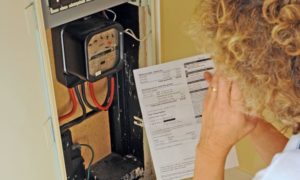
Household energy bills will rise by 20 per cent on average to £3,000 next April after the government said it would only partially continue subsidising higher prices.
The government’s energy price guarantee that started last month will cap average bills at £2,500 only until the spring, saving the Treasury £14 billion. It was initially intended to keep bills at this level until 2024.
But the government will protect up to 24 million households from some of the future increase by capping the average dual fuel tariff at a level that will keep average bills to £3,000 for a year until April 2024.
The Treasury also said it would review the energy bill relief scheme that capped costs for small businesses until the end of next March. It said the overall scale of support “will be significantly lower, and targeted at those most affected”.
Gas prices are expected to stay high for at least the next two years according to the Office for Budget Responsibility. This month the consultancy Cornwall Insight forecast the average household would pay £3,702 a year if the guarantee was not extended.
In April last year, Ofgem’s energy price cap was £1,138 for the average household, more than two and a half times lower than next year’s guaranteed price.
From April, the government said it would consult on “amending the scheme so that those who use very large volumes of energy have their state support capped, whilst the vast majority of households can continue to benefit”.
There will also be no return of the £400 energy rebate that all households with an electricity meter now receive after that scheme ends in April. All households should have received the first two of six instalments of either £66 or £67 since October.
Instead, the government announced a £11.3 billion means-tested round of support that will hand out money to those on working benefits, pensioners and those in receipt of disability benefits. In 2023-24, these groups will receive £900, £300 and £150, respectively.
Those people who are not on the gas grid and who use alternative fuels such as LPG and heating oil will have the support they receive doubled from £100 to £200 in 2023-24.
Richard Neudegg, from the comparison site Uswitch, said: “The impact of the changes will be mostly felt in winter 2023, when energy use is high and there’s no £400 support cushion. While there’s much talk of average figures, it’s important to remember that bills are not frozen. The energy price guarantee is a cap on the unit rate of the energy you use — it is not a cap on your final bill. The less energy you use, the less you will pay, but it’s important to manage your energy usage in a safe way.”
The government also pledged to spend £6 billion more between 2025 and 2028 to improve household energy efficiency and bring down bills by 15 per cent by 2030 compared with last year.
England’s housing stock is poorly insulated, with 58 per cent of privately owned homes having an energy efficiency rating of D or lower, according to the latest English Housing Survey, in 2020-21.
The surge in energy prices since last autumn has already convinced households to pay more attention to their usage and make their properties more energy efficient where they can.
The Energy Saving Trust, a government-run organisation that provides consumer advice, said visits to its website were up 20 per cent compared with last year. Among its most popular pages were those on installing solar panels, the appliances that consume the most energy and how better to insulate your home.
“As energy prices remain high, we know that many people are looking for quick ways to save energy and money on their bills,” Angela Howarth, of the trust said.
“People are looking for clear advice on what energy efficiency home improvements will make the biggest difference to their bills and clarity on how they may benefit from financial support.”
Read more:
Average household energy bills to hit £3,000 a year after April






